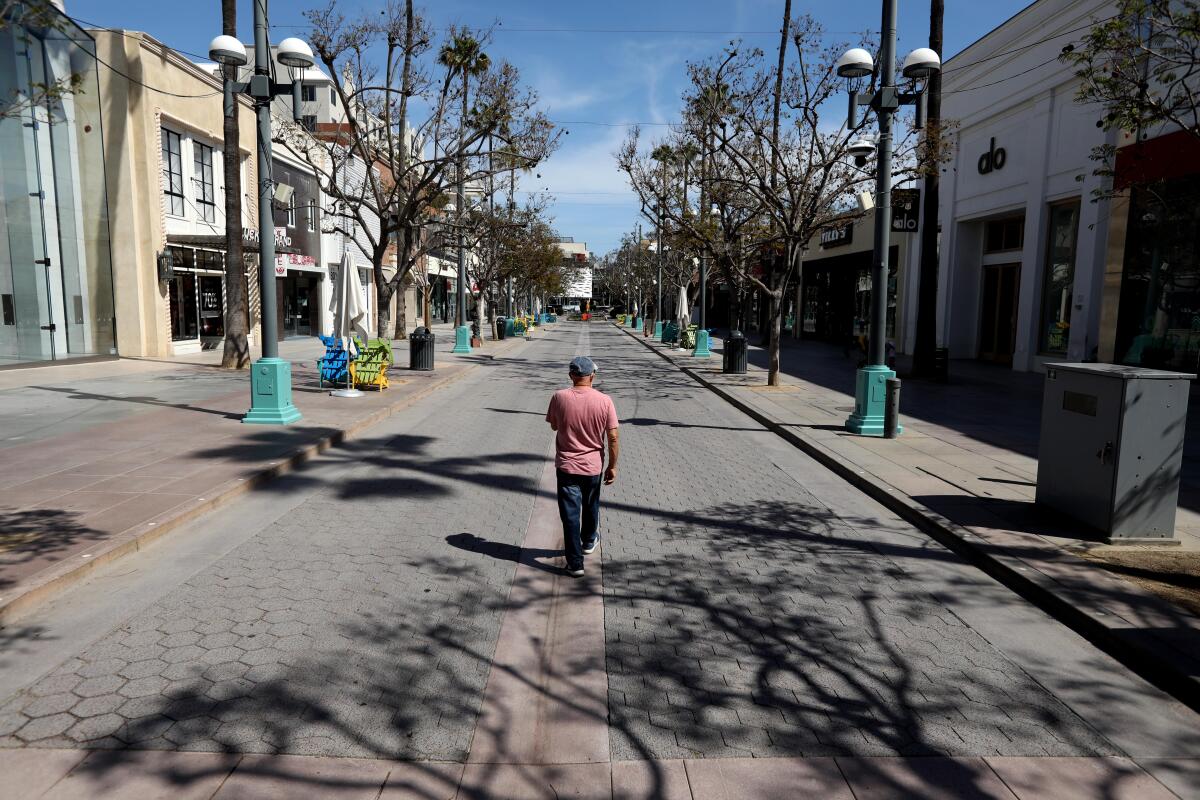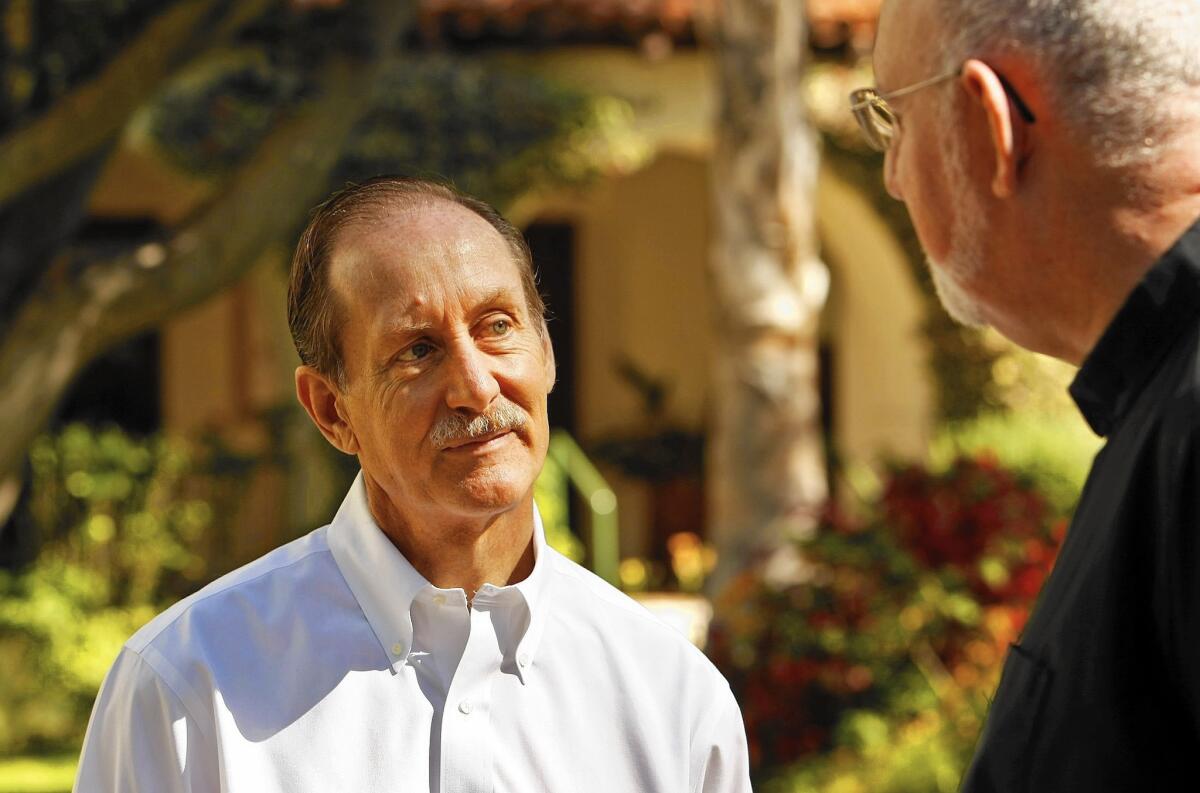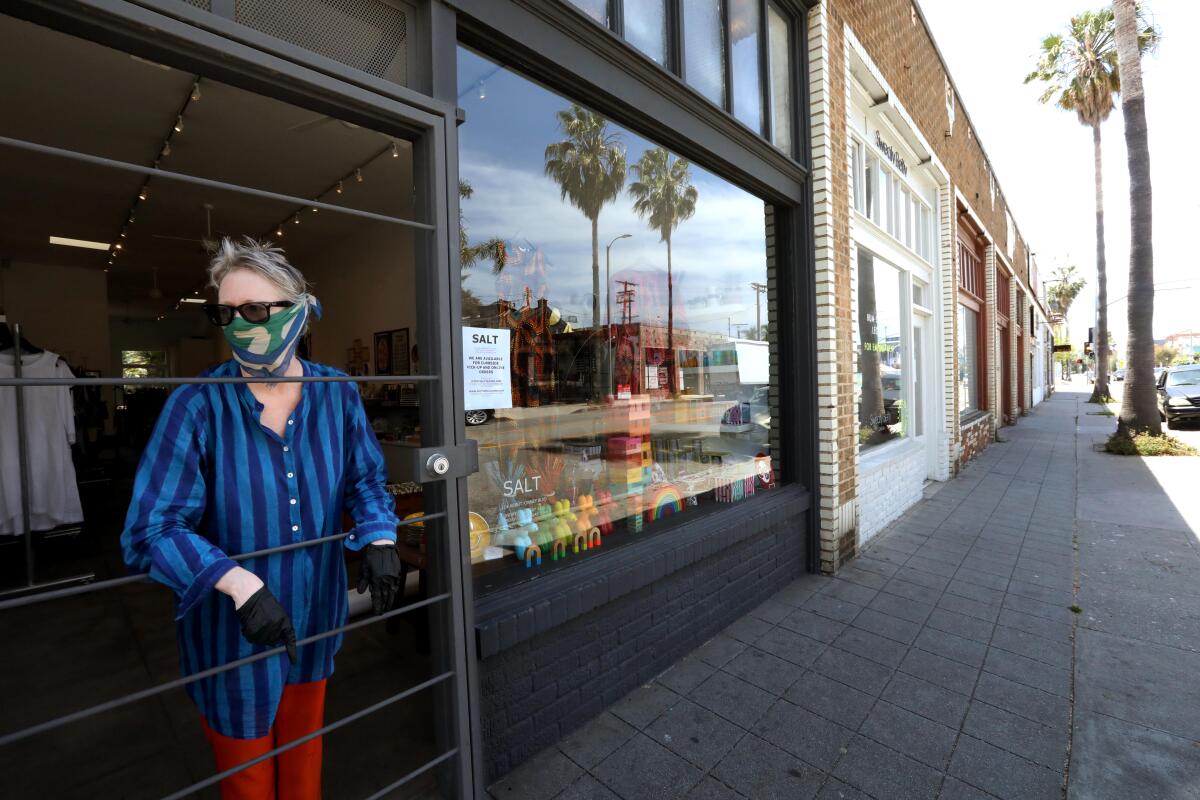Slammed economically by the coronavirus, Santa Monica offers grim preview of crisis to come

Rick Cole spent his career working to shape and move institutions — not big, august ones with world renown, but midsize cities such as Ventura and Azusa. Over 34 years in five city halls, he built a regional reputation as a wizard of municipal reform.
Sharp, outspoken, at times brusque and divisive, he fought to create compact, walk-able communities near public transportation hubs, while pushing to pare bloated budgets, using data to pinpoint inefficient services and employees.
As city manager of Santa Monica, he had been warning for two years that it needed to start paying down its pension debts, because the good times would end, as they always do.
He just didn’t imagine they would end like this.

The coronavirus outbreak and the shutdown severed the city’s two main streams of revenue, hotel bed tax and sales tax. Santa Monica is now looking at a $226-million shortfall by June of 2021. And while the affluent coastal town is better off than most of the 88 cities in Los Angeles County, it is facing drastic cuts and layoffs.
Cole came to realize he was not the person most fit to lead Santa Monica through the coming conflict, having just finished battling employee unions over pension funding.
On April 17, he announced his resignation, firing a shot across the bow of city governments throughout Southern California. Rickety budgets were sailing into a tremendous storm.
The city announced this week plans to lay off or buy out 373 employees.
The economic devastation will tear through city after city, across the Los Angeles Basin, testing poor cities such as Maywood and Bell in the southeast county, to those in the San Fernando and San Gabriel valleys and beyond.
“It is one of those moments that is going to force us to rethink. Shame on us if we don’t use this as an opportunity,” Cole said. “If it’s solely a tragedy — and the only thing that comes of this is libraries and fire stations being closed and public employees being laid off — then we will have compounded the health tragedy with a tragic failure of imagination and political will.”

The California League of Cities estimates cities around the state will collectively lose $7 billion over the next two years due to the pandemic, and billions more if the stay-at-home orders extend into summer and beyond. Nine of 10 cities reported that the shortfall would lead to service cuts or furloughs and layoffs, mainly due to retail sales falling off a cliff. Many had relied on one-cent sales taxes to shore up their budgets.
“If retail sales crater, 1% sales tax doesn’t get you anything. One percent of zero is still zero,” said D.J. Waldie, an author, historian and former Lakewood official for 33 years.
He said cities have fewer options than counties and states in terms of looking for new revenue. “Oftentimes the solution to the state’s problems is to to take the money from other units of the government, counties and cities and special districts. You see a lot of that in the last 15 or 20 years, and there’s no reason for the state not to behave as it has in the past.”
Counties and school districts are partly buffered from financial downturns because they get a much bigger share of property taxes than cities. And ever since Proposition 13 put a limit on that, cities have been cutting services and delaying needed capital improvements.
Now not only is revenue tanking, but the cities’ pension obligations will soar if Wall Street continues to sputter and pension portfolios lose billions in value.

Unlike Santa Monica — which has a per capita budget of twice any other city in the county — many municipalities have few places to cut that don’t affect essential services like police, fire, planning, building and libraries. Long-overdue infrastructure needs will be put off even longer. The scenario is bleak: Asphalt breaks up, park greenery withers, street lights go out, trash doesn’t get picked up, graffiti lingers and property values fall, accelerating the downward cycle.
“The solutions are few and far between, hard to find,” Waldie said.
Cole, 66, started his career as an activist and journalist who co-founded the Pasadena Weekly. He first made a name in the urban planning world as a council member and mayor in Pasadena who helped turn the blighted downtown into an entertainment and retail district that became a national model for redevelopment.
He moved on to become city manager in Azusa and Ventura. It is rare for a politician to move into the more quotidian role of administration, and Cole has been more blunt and outspoken than most managers.
Near the end of his five-year tenure in Santa Monica, some city employees complained that he could be imperious and not transparent — criticism that only grew sharper when the threat of layoffs appeared. A petition demanding his removal had gathered 2,800 signatures.
“What is being restructured, what positions are being eliminated, it’s completely opaque,” said an employee of the human services department. “We ask why are they making these decisions and don’t get any answers.”
Cole had already been down this path, in a sense. In Ventura, he spent four years re-shaping development and the next four dealing with the Great Recession, according to former Mayor Bill Fulton.
“He wanted to get in front of the budget problem,” said Fulton, who now runs an urban think tank focusing mostly on Houston. “Rick was aggressive and got out in front of it. The neighboring cities were slow to cut their budgets, and for quite a while everybody said what’s wrong with Ventura, why does Ventura have a problem that no on else has? And the answer was, thanks to Rick we were confronting the problem head-on early.”
But other members of the City Council complained that he was not deferential to their ideas, talked over them and acted like an elected official, not the manager hired to carry out their vision. He resigned in 2012.
The following year, L.A. Mayor Eric Garcetti hired Cole to be his deputy mayor for budget and innovation, to look for ways to increase efficiency throughout City Hall.
Miguel Santana, Los Angeles’ chief administrative officer at the time, said Cole helped the mayor focus the city’s resources on the services that people cared about the most.
“He likes to look at things systematically and asks fundamental questions about the role of government,” said Santana, now president and chief executive of Fairplex in Pomona.
Santana thought that the Santa Monica job, which Cole began in 2015, would be a perfect fit, because the city was progressive and had the means to make headway on issues such as homelessness and gentrification.
Cole said he hopes those efforts will continue, even as Santa Monica marches, like every other place, into the uncharted territory blazed by the coronavirus crisis. The city should not simply cut staff, he said, while clinging to an ineffective model of government that dates to the Progressive Era and the New Deal.
“Some of the most important things that we should be doing, we are not doing. We weren’t prepared for a pandemic. Housing is not affordable. We’re not solving the homeless crisis. We are maintaining legacy services designed for a different era,” he said.
An example: Santa Monica’s Fire Department responds to more than 15,000 911 calls but fewer than a hundred for actual fires, he said. The vast majority are medical responses.
“If you were designing a service today for optimal medical response, you wouldn’t do it with firetrucks,” Cole said.
To frame the dilemma, made ever so much worse by the pandemic, in Cole’s characteristically colorful fashion:
“Either we try to preserve the bloody stump of the way we used to do things — or we invent new ways of solving today’s problems.”
More to Read
Sign up for Essential California
The most important California stories and recommendations in your inbox every morning.
You may occasionally receive promotional content from the Los Angeles Times.











